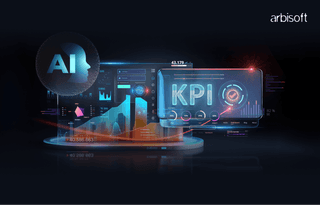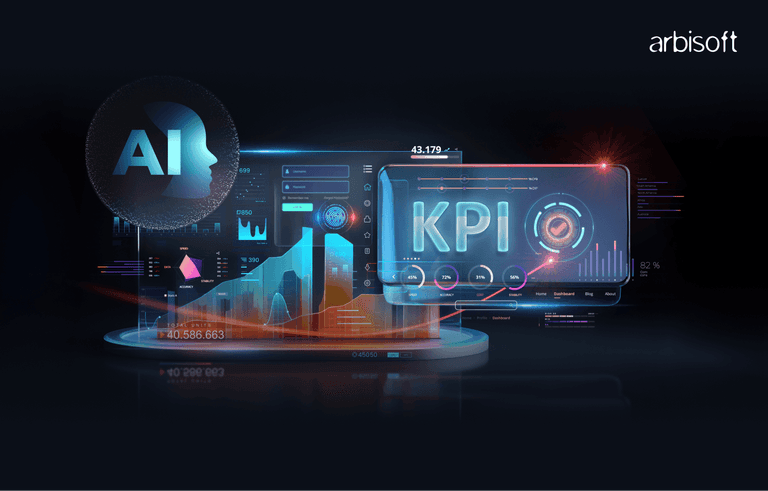We put excellence, value and quality above all - and it shows




A Technology Partnership That Goes Beyond Code

“Arbisoft has been my most trusted technology partner for now over 15 years. Arbisoft has very unique methods of recruiting and training, and the results demonstrate that. They have great teams, great positive attitudes and great communication.”
How Do You Know If Outsourcing Data, AI or ML Services Will Deliver ROI?

Here’s the million-dollar question I hear more than any other:
“Is outsourcing my data, AI, or ML project worth the extra headache? Will it actually pay off?”
No fluff. Just answers.
Let’s get wise about what happens when you trust an outsider with your crown jewels: your data and your future.
Pinpointing the Pain: Why ROI Clarity is Critical in Outsourcing AI, Data, and ML
If you’re even thinking about outsourcing AI or data services, I’ll bet one thing is true.
You need results, not guesswork.
But before you hand over your project, you need clarity. Because if you can’t measure it, you can’t manage it. That’s the rule I live by.
I’ve seen companies close their eyes, write the check, and pray it all works out. Spoiler alert: it rarely does.
You might hit gold. Or you might end up babysitting a vendor who keeps missing deadlines and burning cash.
Let me walk you through where it goes sideways and how you avoid that trap.
The Stakes of Inconsistent Vendor Performance
One client I worked with got dazzled by flashy decks and demo videos. The vendor promised smart AI that would clean their customer data and boost retention.
What they got? A half-built tool, poor documentation, and missed delivery after missed delivery.
The worst part? No KPIs were in place. No one could even say what “done” looked like. The result? Lost money. Lost time. And a team that didn’t trust outsourcing again for years.
Navigating Legacy System Modernization with Limited Budgets
Another case? A company still using billing software built in 2002. I kid you not.
They knew they needed an upgrade, but integration felt like open-heart surgery. That’s not unusual. Over 60% of IT leaders admit their infrastructure is outdated and fragmented.
When budgets are tight, the ROI of outsourcing isn’t just about “can we build this?” It’s about “can we build this without blowing our budget sky-high?”
And unless you do the math upfront, you won’t know.
Aligning Outsourcing Strategies with Market Pressures
It’s not just about your systems.
It’s the market that’s moving fast.
From finance to healthcare, companies are using automation to get ahead. The ones still trying to go it alone? Falling behind.
If you’re feeling that pressure, outsourcing can give you speed and agility, given that you choose the right partner and model.
We’ve covered the why. Now let’s talk about how to tell if outsourcing actually fits.
Analyzing the Solution: Is Outsourcing Your Data, AI, or ML the Right Move?
Not every problem needs an external partner. But when it does, you better pick the right one.
Let’s break down what to look for.
Understanding Outsourcing Engagement Models in IT Industry
There’s no one-size-fits-all.
The engagement models in IT industry vary widely, from staff augmentation to fully managed services, each carrying its own cost structure, risks, and benefits.
You need to know your appetite for risk and your tolerance for surprises.
A Deloitte report showed outsourcing cuts project timelines by up to 50%. But that only happens if you choose an engagement model that matches your goals.
Want flexibility and control? Augmentation might work. Want full ownership off your plate? Managed services are better.
Comparing In-House vs. Outsourced AI and ML Projects
Let’s get real. If AI is the core of your business, investing in an internal team might make sense.
But that takes time. And talent. And training.
In contrast, companies outsourcing machine learning and AI projects have reported strong returns, often achieving positive ROI within the first year.
Still, don’t forget: in-house teams understand your internal politics and tech stack better. Outsourced teams bring fresh eyes, but need onboarding.
Trade-offs are everywhere. Be clear on what you’re giving up and what you’re gaining.
Assessing Outsourcing Companies Through Real Examples and Metrics
You wouldn’t buy a car without a test drive. So why would you hire an AI partner without seeing proof?
Ask for actual performance numbers. Not vague promises.
I once asked a vendor to show me how they’d improved process speed. They gave me a bar chart with no axis labels. That was a hard no.
You want to see defect rates drop. Turnaround times improve. Costs trimmed. Not magic. Just math.
Ready to dig into the numbers? Here’s how to calculate ROI the right way.
Measuring ROI: Frameworks for Data, AI, and ML Outsourcing Success
Talk is cheap. Metrics matter.
Let’s crunch the numbers and see what success really looks like.
How Do You Calculate ROI for AI Projects?
Here’s the simple version:
ROI = (Net Gain – Total Cost) ÷ Total Cost
But you’ve got to track everything. That includes vendor costs, software, development time, training, post-launch support.
Then compare it to what you’re gaining—revenue lift, better accuracy, faster output, fewer complaints.
Don’t forget your baseline. You can’t claim ROI if you don’t know where you started.
How to Calculate ROI for an Automation Project?
Let’s break it down in steps:
- Define clear, measurable goals.
- Baseline your current performance.
- Estimate savings: labor, delay reduction, process accuracy.
- Subtract the cost of the outsourcing services and tools.
- Track and adjust over time.
In 2025, automation cut operational costs by up to 30% and halved data-related delays for top-performing firms.
Those aren’t promises. That’s reality.
Setting and Tracking Outsourcing KPIs
You can’t improve what you don’t measure.
So choose your outsourcing KPIs wisely: budget accuracy, on-time delivery, error rates, employee satisfaction, customer feedback.
Build a dashboard. Keep it simple. But don’t skip it.
When I saw a project tank, it was never because the team didn’t care. It was because they stopped tracking performance after go-live.
Quantifying Cost Savings and Innovation Acceleration
Some companies focus only on cost savings. That’s short-sighted.
When you measure outsourcing ROI, don’t just look at cost savings. The real win is innovation speed.
In 2025, companies that outsourced machine learning saw product launch cycles shrink by 30%. That’s a win that compounds.
It’s not just about spending less. It’s about earning more, faster.
Now, all that data sounds great. Until your old systems throw a tantrum.
Integration Realities: Making Outsourcing Work for Your Tech Stack
Let’s talk about the elephant in the server room: integration.
It’s the make-or-break moment for every outsourced project.
Bridging Legacy Systems and Modern Outsourced Solutions
If your systems are older than your interns, integration won’t be smooth.
And no, that’s not rare. More than 70% of IT budgets still go to maintaining legacy systems.
So what’s the play?
You need AI outsourcing companies that understand hybrid environments. They should offer plug-and-play tools—or at least clean APIs.
If it takes six months just to make two tools talk, you’re not saving time. You’re setting money on fire.
Addressing Performance Consistency and Post-Deployment Support
Here’s the trap: vendors who vanish after deployment.
The ROI of outsourcing doesn’t end at go-live. It depends on uptime, bug fixes, maintenance, and iteration.
Make sure your outsourcing services include support.
Otherwise, you’ll be back where you started—only poorer.
Alright, time to choose your partner.
Decision Factors: Choosing AI Outsourcing Companies That Deliver Value
You’ve seen the models. You’ve done the math.
Now let’s talk about picking the right team.
Evaluating Vendor Transparency and Pricing Models
If you ask for pricing and the answer is a riddle, walk away.
You need clear, predictable costs. Whether that’s per sprint, per feature, or outcome-based, depends on your needs.
But whatever the model, it should be in writing and tied to actual deliverables.
Outsourcing KPIs should be part of that pricing conversation. If they’re not, that’s a red flag.
Ensuring Measurable Outcomes and Strategic Fit
You’re not buying code. You’re investing in outcomes.
I’ve turned down vendors with brilliant engineers because they didn’t get our business goals.
If they can’t talk about your market, your customers, and your competitive pressure, they won’t deliver value.
No matter how clever their AI model is.
And even then, stuff still goes wrong sometimes.
Acceleration or Risk? Navigating Common Pitfalls in Data Science Outsourcing
Speed is nice. But don’t let it blind you to red flags.
Avoiding Hidden Costs and Overpromises
It starts small.
A change request here. A vague deliverable there. Suddenly your budget’s blown.
Lock in scope. Document everything. Push back on vague timelines or shifting requirements.
In short? Don’t buy what you can’t measure.
Building Strong Collaboration with Internal Data Teams
Outsourcing data services doesn’t mean sidelining your internal team.
They’re your best insurance policy.
Get them involved early. Share KPIs. Set expectations together.
When internal teams and vendors collaborate, you avoid duplication, boost trust, and get results faster.
Ready to wrap this up?
Will Outsourcing Deliver ROI for Your Company?
It depends.
But if you’re clear-eyed about what you want, measure everything, and pick the right partner?
It can pay off big.
Decision Checklist for Directors of Data & Analytics
- Are your goals and outsourcing KPIs locked in?
- Do you know your in-house vs. outsourcing trade-offs?
- Is your baseline clear and measurable?
- Did you budget for integration pain?
- Is your vendor clear, accountable, and aligned?
If most of these get a yes, you're on the right path.
Otherwise? You might be buying problems, not solutions.
Long-Term Strategic Alignment and Competitive Advantage
Let me leave you with this.
The ROI of outsourcing isn’t just about saving money this quarter.
It’s about building a tech advantage that compounds over time.
So choose a partner who’s not just selling AI, but sharing your goals.
Then hold them to it.
























